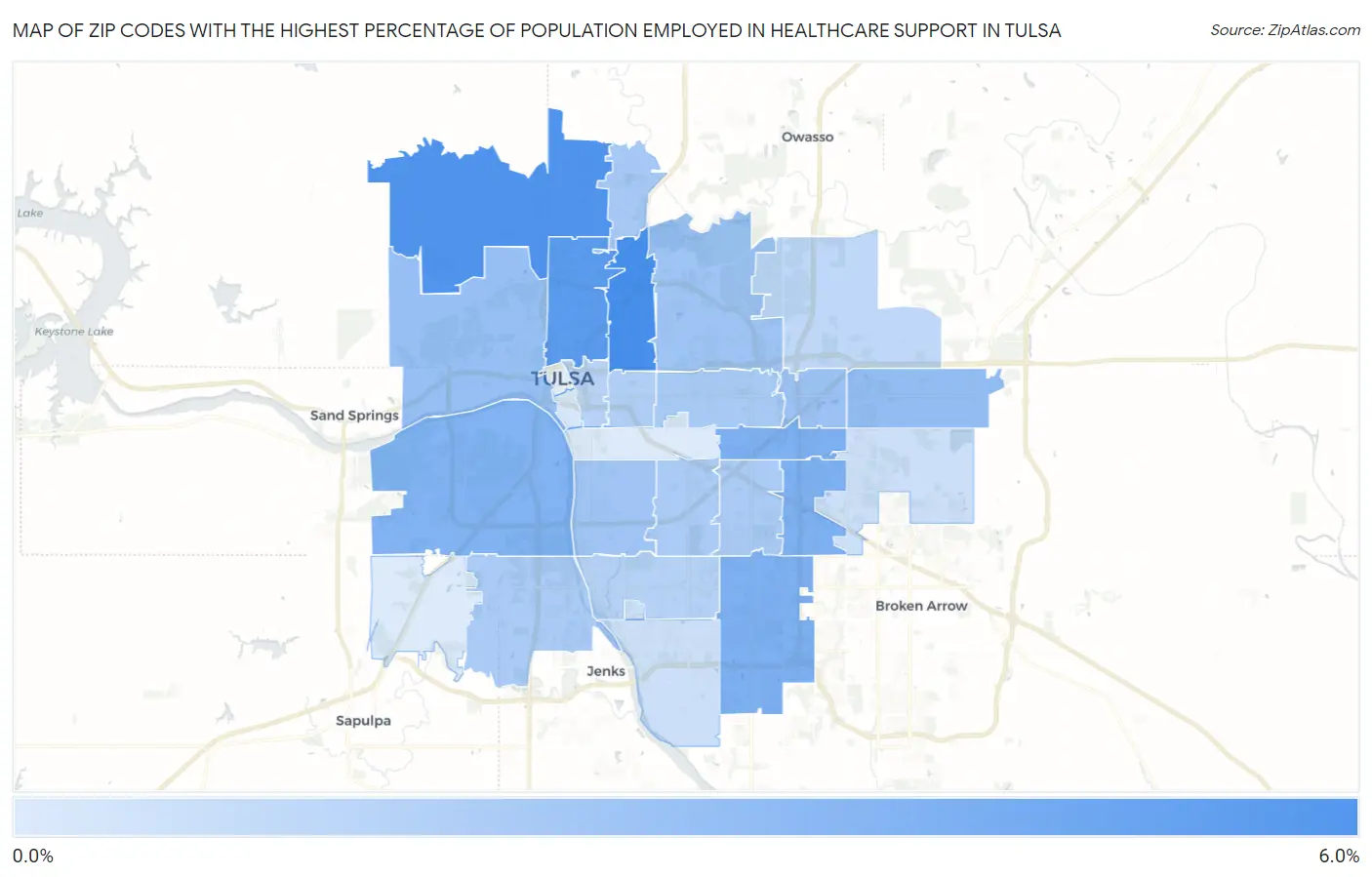Zip Codes with the Highest Percentage of Population Employed in Healthcare Support in Tulsa, OK
RELATED REPORTS & OPTIONS
Healthcare Support
Tulsa
Compare Zip Codes
Map of Zip Codes with the Highest Percentage of Population Employed in Healthcare Support in Tulsa
1.0%
5.6%

Zip Codes with the Highest Percentage of Population Employed in Healthcare Support in Tulsa, OK
| Zip Code | % Employed | vs State | vs National | |
| 1. | 74110 | 5.6% | 3.0%(+2.63)#81 | 3.3%(+2.31)#5,334 |
| 2. | 74126 | 5.3% | 3.0%(+2.31)#95 | 3.3%(+1.98)#6,041 |
| 3. | 74106 | 4.9% | 3.0%(+1.95)#116 | 3.3%(+1.63)#6,915 |
| 4. | 74129 | 3.9% | 3.0%(+0.937)#178 | 3.3%(+0.612)#10,214 |
| 5. | 74146 | 3.9% | 3.0%(+0.901)#180 | 3.3%(+0.577)#10,336 |
| 6. | 74133 | 3.8% | 3.0%(+0.892)#182 | 3.3%(+0.568)#10,367 |
| 7. | 74107 | 3.8% | 3.0%(+0.871)#184 | 3.3%(+0.547)#10,467 |
| 8. | 74108 | 3.2% | 3.0%(+0.293)#242 | 3.3%(-0.031)#12,936 |
| 9. | 74127 | 3.1% | 3.0%(+0.143)#264 | 3.3%(-0.182)#13,643 |
| 10. | 74128 | 2.9% | 3.0%(-0.010)#275 | 3.3%(-0.334)#14,428 |
| 11. | 74115 | 2.9% | 3.0%(-0.086)#288 | 3.3%(-0.410)#14,795 |
| 12. | 74105 | 2.8% | 3.0%(-0.116)#292 | 3.3%(-0.441)#14,949 |
| 13. | 74130 | 2.7% | 3.0%(-0.267)#309 | 3.3%(-0.591)#15,717 |
| 14. | 74112 | 2.6% | 3.0%(-0.332)#316 | 3.3%(-0.656)#16,056 |
| 15. | 74145 | 2.5% | 3.0%(-0.414)#337 | 3.3%(-0.739)#16,534 |
| 16. | 74132 | 2.5% | 3.0%(-0.439)#340 | 3.3%(-0.763)#16,670 |
| 17. | 74135 | 2.5% | 3.0%(-0.443)#341 | 3.3%(-0.767)#16,687 |
| 18. | 74104 | 2.3% | 3.0%(-0.625)#365 | 3.3%(-0.949)#17,650 |
| 19. | 74136 | 2.2% | 3.0%(-0.783)#382 | 3.3%(-1.11)#18,513 |
| 20. | 74120 | 2.1% | 3.0%(-0.812)#388 | 3.3%(-1.14)#18,674 |
| 21. | 74116 | 1.9% | 3.0%(-1.04)#415 | 3.3%(-1.37)#19,965 |
| 22. | 74171 | 1.5% | 3.0%(-1.43)#465 | 3.3%(-1.75)#22,059 |
| 23. | 74137 | 1.5% | 3.0%(-1.44)#468 | 3.3%(-1.77)#22,149 |
| 24. | 74134 | 1.5% | 3.0%(-1.50)#473 | 3.3%(-1.82)#22,394 |
| 25. | 74119 | 1.2% | 3.0%(-1.74)#494 | 3.3%(-2.07)#23,539 |
| 26. | 74131 | 1.0% | 3.0%(-1.91)#506 | 3.3%(-2.24)#24,270 |
| 27. | 74114 | 1.0% | 3.0%(-1.95)#509 | 3.3%(-2.27)#24,401 |
1
Common Questions
What are the Top 10 Zip Codes with the Highest Percentage of Population Employed in Healthcare Support in Tulsa, OK?
Top 10 Zip Codes with the Highest Percentage of Population Employed in Healthcare Support in Tulsa, OK are:
What zip code has the Highest Percentage of Population Employed in Healthcare Support in Tulsa, OK?
74110 has the Highest Percentage of Population Employed in Healthcare Support in Tulsa, OK with 5.6%.
What is the Percentage of Population Employed in Healthcare Support in Tulsa, OK?
Percentage of Population Employed in Healthcare Support in Tulsa is 2.9%.
What is the Percentage of Population Employed in Healthcare Support in Oklahoma?
Percentage of Population Employed in Healthcare Support in Oklahoma is 3.0%.
What is the Percentage of Population Employed in Healthcare Support in the United States?
Percentage of Population Employed in Healthcare Support in the United States is 3.3%.